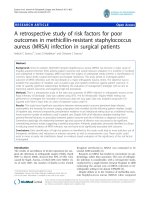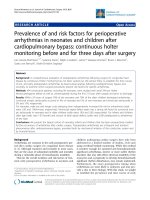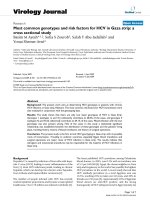CommunityBased Study of Risk Factors for Stroke in Da Nang, Viet Nam
Bạn đang xem bản rút gọn của tài liệu. Xem và tải ngay bản đầy đủ của tài liệu tại đây (2.37 MB, 46 trang )
Da Nang Department of Health
Community-Based Study of Risk Factors for
Stroke in Da Nang, Viet Nam
Annette L. Fitzpatrick, PhD
Dept. of Epidemiology, Adjunct Global Health
University of Washington
Quang Van Ngo, MD, MPH
Da Nang Department of Health
Da Nang, Vietnam
Acknowledgments
Da Nang Department of Health
Kiet A. Ly, MD, MPH, Northwest Center To Reduce Oral Health Disparities
Thanh G N. Ton, PhD, Department of Neurology
David L. Tirschwell, MD, Department of Neurology
W.T. Longstreth, MD, MPH, Department of Neurology
Tung T. Vo, MD, Department of Health, Da Nang
Chien H. Pham, Director, Department of Health, Da Nang
Contents of Presentation
• Need to Study CVD in Developing Nations
• Burden of Stroke
• Introduction to our Project in Da Nang
• Community Survey Methodology
• Community Survey Preliminary Results
Why Study CVD in Developing
Countries?
• Life expectancy is increasing in absolute and
relative terms worldwide
• Majority of CVD mortality and morbidity occurs in
older adults
• CVD may differ in risk factors, presentation, and
course across gender, age, ethnicity, geography
• CVD = primary cause of death worldwide
• Neurological diseases = highest burden of
disease as measured by DALYs
CVD = Global Issue
Source: WHO
Estimated Global Deaths by Cause
All Ages 2005
Deaths (m illions) 20000
18000
16000
14000
12000
10000
8000
6000
4000
2000
0
HIV/AIDS Tuberculosis Malaria Cardiovascular Cancer Chronic Diabetes
Disease Respiratory
Disease
Not Just an Issue in High Income
Countries
Projected Global Distribution
of Chronic Disease Deaths
By World Bank Income Group, 2005
High Income Low Income Countries
Countries 20% 35%
Upper Middle Income
Countries 8%
Lower Middle Income
Countries
37%
Impact of Stroke Globally
•1:3 persons will experience a stroke, dementia or both
(Hashchinski, Stroke 2006)
•Stroke will kill about 10% of the world’s population of 6.5 billion
people and leave millions of others disabled (Lancet 2007)
•Cerebrovascular diseases = highest in number of DALY’s in
the developing world (WHO 2006)
• Stroke is a costly disease:
– Large numbers of premature deaths,
– Ongoing disability in many survivors,
– Impact on families or caregivers
– Impact on health services (WHO Stroke STEPS)
Stroke in Vietnam
• Health Transition from Infectious to Chronic
Disease
• Stroke = #1 Cause of Death (20-27%) (Minh 2003,
Scand J Pub Health; Hoang 2006, Prev Chron Dis)
• Prevalence of Key Risk Factors High
– Smoking
– Hypertension
Stroke in Vietnam
Results for adults aged Both Sexes Males Females
25-64 years (incl. 95% CI) 1.7(± 0.3)
1.6(± 0.3)
Step 1 Tobacco Use 29.7(± 1.1) 60.0(± 1.8) 7.0(± 1.3)
28.4(± 1.1) 57.3(± 1.9)
Percentage who currently 11.1(± 0.4)
smoke tobacco 11.2(0.4)
Percentage who currently
smoke tobacco daily
Mean number of
manufactured cigarettes
smoked per day
Results for adults aged 25-64 years Both Sexes Males Females
Stroke in Vietnam
(incl. 95% CI)
Step 2 Physical Measurement
Percentage with raised BP (SBP ≥140 19.2(± 0.9) 23.1(± 1.6) 15.4(± 1.0)
and/or DBP ≥90 mmHg or currently on 11.9(± 0.8) 12.4(± 1.2) 11.5(± 0.9)
medication for raised BP)
Percentage with raised BP (SBP ≥160
and/or DBP ≥100 mmHg or currently
on medication for raised BP)
• What are characteristics of stroke in Da Nang ?
FIC R21 Grant: 06/99 – 05/11
Collaborated between UW and DOH
Evaluation of stroke risk factors in Da Nang, Viet Nam
OBJECTIVES
• To assess the situation of stroke and its risk
factors in Da Nang
• To enhance the capacity of health staff in
stroke care, treatment, and research.
A. Evaluate stroke and its risk factors in Da Nang
2 Projects
• Designed and conducted a household survey to evaluate risk
factors of stroke: approx. 900 households – 1621 participants
35 yrs and older
• Develop a stroke registry patients hospitalized in Da Nang
Hospital (using WHO STEPS questionnaire)
497 cases were collected from Mar – Nov. 2010.
Lists of stroke patients from other hospitals will also be
collected to evaluate the burden of the disease.
B. Building capacity:
• Established a local Advisory Committee to provide guidance on
methodological approaches and other issues of importance in conducting
research on stroke in Da Nang and potentially other chronic diseases in
the future;
• Organized training courses to enhance capacity for local health staff in
stroke care and research (6 courses: Clinical Stroke, Imaging,
Epidemiology, EpiInfo, Field Data Collection, Stroke Registry Training).
• Organized meetings between experts from the UW and local staff to
exchange idea on establishing a better stroke care system/ unit at Da
Nang hospital.
• Provided equipment (computers, projector, books) to Da Nang Hospital
and DN Health Staff Training Center.
Maps of Viet Nam & Da Nang
Geographic information of Da Nang
• AREA: 1,255.5 km2 Seattle: 1,245 km2
(2009) = 602,000
• POP: 890,000
• 7 districts: - 4 urban,
- 2 half urban-rural
- 1 rural-mountainous
• 56 communes:
• Literacy # 95%
• Income per capita per year: #1,500 USD
• Number of physician: 761 (2009) # 1/1200
DA NANG HEALTH NETWORK
7 District 56 commune Health Stations
Health (CHS). Each has 5-7 staff.
Centers Provide primary health care, first -
aid, and basic treatment.
Each DHC has from 50 to 100 in-patient
beds and also supervise primary health Beside the treatment functions, provincial institutes also
care activities of CHSs in the district provide their accordant specialty support and
supervision to primary health care programs conducted
at DHCs and CHSs (for ex: the community mental care
program, CBR, child malnutrition, prenatal care, etc.)
Da Nang Provincial Institutes Main functions
Health Da Nang Hospital The biggest central hospital in Da Nang with about 1,200 in-patient beds
Department Training Center for Medical Staff Organize continuing training courses for medical staff
Design and conduct health information and education programs
4 private hospitals: Health Information & Education Center Treatment, management mother and child health care programs
50-150 patient beds /each Center for Reproductive Health Treatment, management of the national program of mental care
Mental hospital Treatment, management of Community Based Rehabilitation program
Rehabilitation Center National vaccination programs, nutritional program, epidemic controls, etc
Preventive Medical Center HIV/ AIDS control programs
HIV/AIDS Control Center Treatment, management of community eye care programs
Eye Hospital Treatment, management of dental care programs in school & communities.
Dental Care Center Treatment, management of the national tuberculosis program
Tuberculosis Hospital Treatment, management of the national leprosy program
Dermatological Hospital Food and hygiene inspection
Food Safety and Hygiene Agency Provide forensic examination
Forensic Medicine Center Treatment.
Traditional Medicine Hospital.
Da Nang Pharmaceutical company
Detail Sampling Schema
Da Nang = 7 Name of Districts Number of Hamlets x Number of
Districts: and number of Hamlets in selected Households households
Communes Commune
• 4 Urban 5H x 30hh 150hh
Hai Chau = 13C 1C =56H 150hh
150hh
3 Urban D = 30 C Thanh Khe = 10C 1C =32H 5H x 30hh
Son Tra = 7C 1C =73H 5H x 30hh
• 2 Rural/Urban 1 Rural/Urban D = 4 C NHSon = 4C 1C =53H 5H x 30hh 150hh
• 1 Rural 1 Rural D = 11 C
1C =15H 5H x 30hh 150hh
Hoa Vang = 11C 1C =13H 5H x 30hh 150hh
Sampling: Community Survey
• Sampling: Stratified 50% Urban, 50% rural
• Randomly Selected: 3 (of 30) urban communes
2 (of 11 ) rural
1 (of 4) rural/urban
• Randomly Selected 5 hamlets in each commune
• Randomly Selected 30 HH in each hamlet
• Interviewed Adults 35+ in each HH
Data Collection
• Verbal Informed Consent
• Home Interview – WHO Steps
– Demographics (age, education, religion, SES ownership
questions
– Medical History (CVD, hypertension, diabetes,
hyperlipidemia, cancer, arthritis, COPD
– MI Chest Pain (derived from Rose Angina Q)
– Questionnaire for Verifying Stroke-Free Status
– Health Behaviors (Tobacco, Alcohol, PA, Limited Diet)
– Cognitive Function
– Stress and Anxiety
Data Collection
• Examination
– Vital Signs : Seated BP, Heart rate
– Anthropometry: Height, Weight, Waist, Hips, Knee-Heel
Length
– Spirometry (Peak Flow and FEV)
– Gait Speed
– Timed Chair Stands
– Balance Stands
– Blood Spot (Whatman cards)









